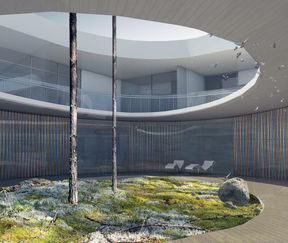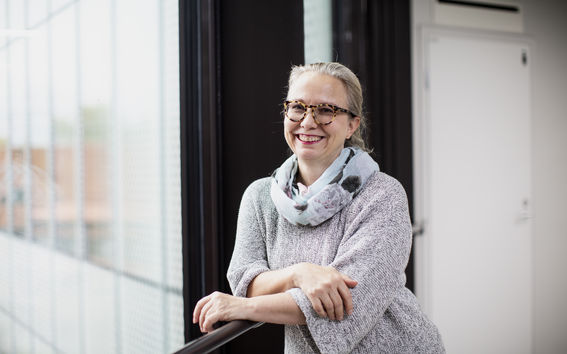Wellbeing and people’s experiences at the centre

We need hospitals and treatment facilities that, in addition to curing diseases, also support people’s holistic wellbeing. The human-centric design gives all the five senses the opportunity to take hold of things that calm the mind and create a feeling of safety. ‘As the population ages, more and more people are experiencing their dying moments at a chronic ward in a hospital or in housing units for elderly people where the environment is either institutional, or at the very least, far from being peaceful and relaxing. In spaces that are human-centred in design, a person’s life can gracefully come to an end’, says Laura Arpiainen, Professor of Practice for Health and Wellbeing Architecture at Aalto University.
As death approaches, people’s senses gradually fade, with hearing typically being the sense that lasts longest. What is the last sound that you’d like to hear? Is it a beeping buzzer, the patter of hurried steps, or a phone ringing. Or could it be the sound of the wind, of lapping water, or a chirping bird? These were the kind of issues that Aalto University’s architectural students dealt with last spring when they were given the task of designing an end-of-life care home. The Design for End of Life Care course involved pondering a big question: what would be a good environment to die in?

Laura Arpiainen, Professor of Practice for Health and Wellbeing Architecture at Aalto UniversityI want to make the patient and family focus more important in the design of healthcare facilities.
Home-like environments instead of institutions
‘For those whose lives are about to end, an end-of-life care home is the last place they will be and the days leading up to their death are also tough for their whole family. A home-like environment gives you room to prepare for death and take care of any last things that need to be dealt with’, Arpiainen adds.
During the course, the students got a feel for how a variety of actors often need to be gathered around the table when starting the design work. The students had to put themselves in different roles, such as that of the dying patient, a nurse, a chief physician, a psychologist, a volunteer and a gardener. Arpiainen explains, ‘A dog therapist providing comfort with pet animals had to justify why bushes and water points were needed in the yard, and the municipal politician had to listen to the neighbours’ complaints about the “death centre”. The organist talked about the need for good sound insulation in the walls. Good design of care facilities is about much more than just deciding the bed layout’.
The City of Espoo gave the course an empty plot of land in Nuottalahti, next to the sea. ‘Throughout this course, we planted the first seeds towards the eventual goal of building an end-of-life care home on this plot. There are only four end-of-life care homes in Finland and we definitely need more’, Arpiainen says.
Both a workplace and a home
In a hospital, infection prevention and strict hygiene requirements largely dictate the design of the facilities and choice of materials. On the other hand, an end-of-life care home can have wooden surfaces and plants; it can be a place where you can wrap yourself up in your own blanket and enjoy the presence of pets as well.
Good design of care environments takes all senses into account. Nature can also bring comfort. A student of landscape architecture who was on the course created a multisensory therapeutic garden that surrounds the building and gives patients, for example, the opportunity to experience the warmth of the sun on their face or the feel of the soil between their fingers one more time. The designs for the courtyard included sweet-smelling bushes, colourful plants and a tucked-away place for spending time alone. Aalto Media Lab helped with the sound design for the indoor and outdoor areas.
The father of a student who was on the course had recently died after having been in hospital for a long time and the student had found the hospital environment oppressive, and with a lack of facilities for nurses. For that reason, he designed a home-like end-of-life care home in which the needs of the personnel are also taken into account. ‘End-of-life care homes and other care environments are at the same time both workplaces and homes. Workers need safe and appropriate working conditions and patients need a home-like environment. Unfortunately, the latter is often sacrificed because of the requirements for treatment: we build institutions’, Arpiainen adds.
From delivery rooms to nursing homes
Arpiainen is the first Professor of Humanitarian Architecture both at Aalto University and in Finland as a whole. The professorship combines health and wellbeing with the design of human-centred living environments, both of which are key research areas at Aalto. The objective is to take into consideration people’s wellbeing as a whole when planning care services and care environments. Arpiainen says, ‘The medical care process and its technical requirements are essential in the planning of care facilities, but it must also be understood that patients are people. Through my work, I want to be advancing the impact and status of patient-centred and family-centred design’.
Arpiainen took up her position at the Department of Architecture in September 2018 when she returned to Finland after having spent more than 20 years living in Canada. In Canada, Arpiainen worked in architectural offices and the provincial health care administration and specialised in the design of health care buildings. Arpiainen’s professorship covers a wide range of health care facilities and services, from delivery rooms to supported housing and care for the elderly. Her fields of teaching and research also include urban health.
‘I want to be involved in creating environments in which human wellbeing is at the centre. A broad approach and an open attitude towards learning can take us a long way. It is great that at Aalto, I can engage in interdisciplinary cooperation between different fields of design’, she says.
Text: Marjukka Puolakka
We are seeking donations to ensure the continuation of both the professorship of practice in health and wellbeing architecture and of teaching and research in this field.
Interested in donating? Contact







